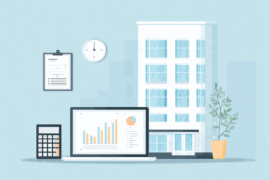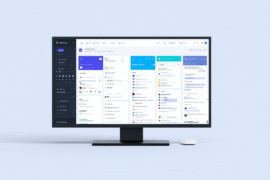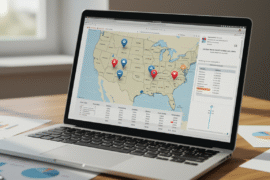This article may contain references to products or services from one or more of our advertisers or partners. We may receive compensation when you click on links to those products or services. Nonetheless, our opinions are our own.
The information presented in this article is accurate to the best of our knowledge at the time of publication. However, information is subject to change, and no guarantees are made about the continued accuracy or completeness of this content after its publication date.
- What Is Cybersecurity?
- Importance of Cybersecurity
- Common Tech Trends Increasing Cyber Risk
- The Cybersecurity Skills Gap in 2025
- Types of Cybersecurity
- Common Cyber Threats
- Cybersecurity Myths and Misconceptions
- Best Practices for Cybersecurity
- Cybersecurity Training and Awareness
- Choosing a Cybersecurity Platform
- Frequently Asked Questions
- Recommended Reads
What Is Cybersecurity?
Cybersecurity refers to the practice of protecting systems, networks, programs, and data from digital attacks. These cyberattacks are typically aimed at accessing, changing, or destroying sensitive information, interrupting normal business processes, or extorting money from users. As more personal and business activities move online, cybersecurity has become a vital part of modern life.
Importance of Cybersecurity
In 2025, the importance of cybersecurity continues to rise as digital transformation accelerates across industries. With more data being stored online and more services relying on cloud and mobile platforms, the risk of breaches has increased significantly. Effective cybersecurity protects not just individual users but also critical systems in healthcare, finance, government, and infrastructure. Cybersecurity measures help reduce financial losses, maintain customer trust, and ensure business continuity.
Common Tech Trends Increasing Cyber Risk
Emerging technologies like artificial intelligence (AI), the Internet of Things (IoT), and remote work tools have introduced new vulnerabilities. As more devices connect to the internet, attack surfaces grow. Cloud adoption has also led to more complex security configurations. Without proper oversight, these technologies can be exploited by attackers looking for weak links in an organization’s defenses.
The Cybersecurity Skills Gap in 2025
The demand for skilled cybersecurity professionals far outpaces supply. This global talent shortage makes it difficult for organizations to find qualified individuals to secure their systems. As cyber threats become more sophisticated, companies struggle to maintain up-to-date defenses. Bridging this gap requires increased investment in cybersecurity education, training programs, and certifications to build a strong and capable workforce.
Voted "Best Overall Budgeting App" by Forbes and WSJ
Monarch Money helps you budget, track spending, set goals, and plan your financial future—all in one app.
Get 50% OFF your first year with code MONARCHVIP
Types of Cybersecurity
Network Security
Network security focuses on protecting internal networks from intrusions by securing both hardware and software. This includes firewalls, VPNs, and monitoring tools that detect and block unauthorized access or malicious activity.
Endpoint Security
Endpoint security protects individual devices such as laptops, smartphones, and desktops from cyber threats. Antivirus software, mobile device management, and behavior analysis are used to defend against endpoint vulnerabilities.
Application Security
Application security involves identifying and fixing vulnerabilities in software applications. Regular code reviews, penetration testing, and secure development practices help prevent exploits at the application layer.
Cloud Security
Cloud security includes policies, technologies, and controls that protect data, applications, and infrastructure in the cloud. This includes identity management, encryption, and compliance controls to secure both public and private cloud environments.
Critical Infrastructure Security
This area focuses on protecting physical and digital systems that are essential to public safety and the economy. It includes the defense of sectors like energy, water, transportation, and communications from cyber sabotage or attacks.
Common Cyber Threats
Malware
Malware is malicious software designed to harm, exploit, or disable devices and systems. It includes viruses, worms, spyware, and trojans. Malware can steal data, lock users out of systems, or turn devices into botnets.
Phishing
Phishing involves fraudulent messages, often emails, that trick users into revealing personal information or credentials. These messages may appear to come from trusted sources but are crafted to deceive and exploit human behavior.
Ransomware
Ransomware encrypts a victim’s files and demands payment, usually in cryptocurrency, to restore access. Attacks on hospitals, schools, and corporations have shown the devastating effects of ransomware on critical operations.
Social engineering manipulates people into giving up confidential information. Attackers may impersonate co-workers or IT staff to gain access to systems, bypassing technical defenses entirely.
Insider Threats
Insider threats come from within an organization employees, contractors, or partners who misuse access to harm the company. Whether intentional or accidental, these threats are often difficult to detect and prevent.
Credential Theft and Account Abuse
Credential theft involves stealing usernames and passwords to gain unauthorized access to systems. Attackers may then use these accounts to move laterally, steal data, or escalate privileges within the network.
Distributed Denial-of-Service (DDoS)
DDoS attacks flood a network or website with traffic, overwhelming systems and making them unavailable to users. These attacks are often used as a distraction while more severe breaches occur in the background.
AI Attacks
AI-powered attacks use machine learning to adapt and evolve, making them harder to detect. Cybercriminals can use AI to automate phishing, identify system weaknesses, or evade traditional security solutions.
Cryptojacking
Cryptojacking hijacks devices to mine cryptocurrency without the owner’s knowledge. It can degrade performance, shorten hardware lifespan, and increase energy consumption, all without raising immediate suspicion.
Cybersecurity Myths and Misconceptions
Myth 1: Strong passwords are enough
While strong passwords help, they are not sufficient on their own. Multi-factor authentication, password managers, and user behavior monitoring are necessary to prevent unauthorized access and credential abuse.
Myth 2: Most threats are already known
Many threats are zero-day exploits or newly created malware variants that existing defenses may not recognize. Threat landscapes evolve rapidly, requiring constant updates and proactive monitoring.
Myth 3: All attack vectors are secured
No system is ever 100% secure. New vulnerabilities are discovered regularly, and attackers constantly find creative ways to bypass security measures. Continuous assessment is essential.
Myth 4: Certain industries are immune
No industry is completely immune to cyber threats. Healthcare, manufacturing, education, and small businesses are increasingly targeted due to valuable data and weaker defenses.
Myth 5: Small businesses aren’t targets
Small businesses are often seen as low-hanging fruit by attackers. They may lack dedicated security teams and strong defenses, making them attractive targets for cybercriminals.
Best Practices for Cybersecurity
Data Loss Prevention (DLP)
DLP tools monitor and control data transfers to prevent sensitive information from being leaked, either accidentally or maliciously. They are essential for regulatory compliance and data protection.
Endpoint Detection and Response (EDR)
EDR systems detect and respond to threats at the endpoint level. They collect data from devices and analyze it for patterns of malicious activity, enabling faster incident response.
Intrusion Prevention Systems (IPS)
IPS technology monitors network traffic for suspicious behavior and blocks potential threats in real time. It complements firewalls and antivirus tools for deeper protection.
Next-Generation Firewalls (NGFWs)
NGFWs provide advanced features such as deep packet inspection, intrusion prevention, and application control. These firewalls offer more nuanced security than traditional ones.
Secure Access Service Edge (SASE)
SASE combines networking and security into a cloud-delivered model. It supports secure remote access and offers consistent security policies regardless of user location.
Security Information and Event Management (SIEM)
SIEM platforms collect and analyze logs from across the IT environment. They help detect anomalies, streamline compliance, and provide insights into security events.
Security Orchestration, Automation, and Response (SOAR)
SOAR solutions automate incident response processes. They reduce response times, improve consistency, and free up security teams to focus on complex threats.
Cybersecurity Training and Awareness
Employee training is a crucial layer of defense. Awareness programs educate users on recognizing threats like phishing, social engineering, and suspicious behavior. Regular training helps build a culture of security and reduces human error, which is often the weakest link in cybersecurity.
Choosing a Cybersecurity Platform
Scalability
A good platform should grow with your organization. It must handle increased data, users, and endpoints without compromising performance or protection.
Integration
Cybersecurity tools must integrate seamlessly with existing infrastructure. Unified systems enable better visibility, reduce blind spots, and enhance threat detection.
Threat Intelligence
Built-in threat intelligence helps identify and defend against emerging threats. It offers real-time updates and global threat feeds to keep defenses current.
Automation
Automated detection and response reduce human error and speed up containment. Look for platforms with built-in workflows and customizable alerts.
User Interface
An intuitive dashboard allows security teams to monitor systems efficiently. Clear reports and accessible features improve usability across different skill levels.
Compliance Support
Platforms should offer tools to meet compliance requirements like GDPR, HIPAA, or ISO. Automated reporting and policy templates can simplify audits and documentation.
Frequently Asked Questions
What is the most common cybersecurity threat today?
Phishing remains one of the most prevalent threats. Cybercriminals use fake emails and websites to trick users into revealing personal or financial information. These attacks are highly effective and continuously evolving, targeting both individuals and businesses.
How can I protect my small business from cyberattacks?
Small businesses should start with basic security hygiene: install antivirus software, enable firewalls, update software regularly, and use strong passwords with multi-factor authentication. Employee training and secure backups also play vital roles in preventing and mitigating attacks.
Is antivirus software enough for cybersecurity?
Antivirus software is a basic layer of defense, but it’s not enough on its own. Modern threats require more comprehensive protection, including firewalls, behavior analytics, endpoint detection, and regular security audits to ensure full coverage.
What is zero trust security?
Zero trust is a security framework that assumes no user or device should be trusted by default, even within the network. It requires continuous authentication, authorization, and validation of all access requests to ensure maximum protection against internal and external threats.
Why is cybersecurity important for remote work?
Remote work expands the attack surface by introducing unsecured home networks and personal devices. Cybersecurity measures like VPNs, endpoint security, and secure cloud access help protect sensitive data and maintain productivity in remote environments.
How does cybersecurity work?
Cybersecurity works by implementing a combination of technologies, policies, and practices designed to detect, prevent, and respond to cyber threats. It includes tools for monitoring networks, securing data, managing user access, and training people to identify suspicious behavior.

Reviewed and edited by Albert Fang.
See a typo or want to suggest an edit/revision to the content? Use the contact us form to provide feedback.
At FangWallet, we value editorial integrity and open collaboration in curating quality content for readers to enjoy. Much appreciated for the assist.
Did you like our article and find it insightful? We encourage sharing the article link with family and friends to benefit as well - better yet, sharing on social media. Thank you for the support! 🍉
Article Title: Cybersecurity Tips and Threat Protection Guide for 2025
https://fangwallet.com/2025/07/29/cybersecurity-tips-and-threat-protection-guide-for-2025/The FangWallet Promise
FangWallet is an editorially independent resource - founded on breaking down challenging financial concepts for anyone to understand since 2014. While we adhere to editorial integrity, note that this post may contain references to products from our partners.
The FangWallet promise is always to have your best interest in mind and be transparent and honest about the financial picture.
Become an Insider

Subscribe to get a free daily budget planner printable to help get your money on track!
Make passive money the right way. No spam.
Editorial Disclaimer: The editorial content on this page is not provided by any of the companies mentioned. The opinions expressed here are the author's alone.
The content of this website is for informational purposes only and does not represent investment advice, or an offer or solicitation to buy or sell any security, investment, or product. Investors are encouraged to do their own due diligence, and, if necessary, consult professional advising before making any investment decisions. Investing involves a high degree of risk, and financial losses may occur including the potential loss of principal.
Source Citation References:
+ Inspo
There are no additional citations or references to note for this article at this time.












































